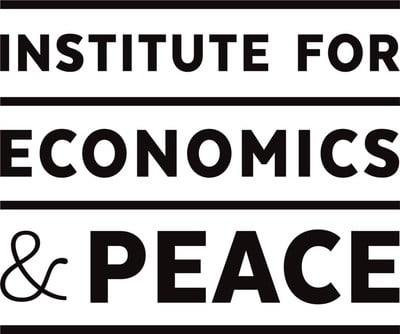Press Release
Conflict risk escalates amid rising food and water scarcity and inflationary pressures, reports the Institute for Economics & Peace

[ad_1]
LONDON, Nov. 1, 2023 /PRNewswire/ — Today marks the annual launch of the Ecological Threat Report, produced by the Institute for Economics & Peace (IEP).

Key Findings:
- Ecological threats, such as rapid population growth, water risk and food insecurity will be compounded by climate change, causing mass displacement of people and conflict.
- A 25% rise in food insecurity increases the risk of conflict by 36%
- Similarly, a 25% increase in the number of people without access to clean drinking increases the likelihood of conflict by 18%
- 1 billion people are living in 42 countries that currently face severe food insecurity
- 1 in 4 people globally do not have regular access to safe drinking water
- By 2050, 2.8 billion people will reside in countries facing severe ecological threats, compared to 1.8 billion today
- More than 60% of the world’s megacities are growing rapidly and are in countries with high levels of violence or conflict. These cities lack the financial resources to cater for their population growth.
The Ecological Threat Report (ETR) analyses ecological threats globally and assesses the countries and subnational areas most at risk from conflict, civil unrest and displacement caused by ecological degradation and climate-related events. The report covers 221 countries and independent territories broken down into 3,594 subnational areas.
The main finding from the ETR is that without concerted action, current levels of ecological degradation will worsen, intensifying existing conflicts, and becoming a catalyst for new conflicts, thereby resulting in increases in forced migration.
The number of countries suffering from severe ecological threats and low societal resilience has risen by 3 to 30 in the last year. These ‘hotspot’ countries are home to 1.1 billion people, an increase of 332 million(1). The recent pressures on global food prices have placed additional demands on countries already suffering from food insecurity.
Hotspot Countries
Three new countries have emerged as ‘hotspots’. They are Niger, Ethiopia, and Myanmar, all of which have entered a detrimental cycle of increasing ecological threats, lower societal resilience and escalating conflict. Each has faced famine and violence in the last 12 months: Ethiopia’s ongoing conflict, Niger’s recent military coup, and Myanmar’s violence following its coup in 2021.
Ecological degradation and conflict are cyclical, whereby the degradation of resources leads to conflict, while conflict leads to the degradation of resources. Ecological degradation has the biggest impact on conflict in regions like the Sahel, which face major deficiencies in governance, rule of law, high levels of poverty and short-term climatic variations.
Conflicts often spillover from one country into another, affecting the region and beyond(2). Currently there are over 108 million people that are displaced, up by 24% since 2020. Estimates show that 30 per cent of all displacements move more than 500 kilometres beyond their home country, with a significant percentage of illegal entries in Europe originate from ecologically threatened and conflict-ridden countries(6). A significant percentage of Europe’s illegal entries, notably 29% from Syrian and 9% from Afghanistan, are from hotspot countries.
Based on current trends, and without substantial efforts to reverse them, IEP estimates show that by 2050, 2.8 billion people will reside in countries facing severe ecological threats compared to 1.8 billion in 2023.
Conflict, Food and Water Stress
Food insecurity is connected to water stress. The ETR estimates that a 25% rise in food insecurity increases conflict risk by 36%, similarly a 25% increase in water risk escalates the likelihood of conflict by 18%. Areas with a history of conflict and weak institutions are the most vulnerable.
Global food prices have increased by 33% since 2016, placing further stress on the most vulnerable. Currently, 42 countries face severe food insecurity, with almost four billion people living in areas with high or severe food insecurity. Most of these countries are in Sub-Saharan Africa.
Two billion people currently live in countries without access to safe drinking water. By 2040, the MENA region will mirror sub-Saharan Africa’s water stress. Eight of the 12 countries in Russia and Eurasia currently face significant water challenges, exacerbated by low rainfall and their topology.
These trends are expected to worsen. It is likely that global warming will exceed 1.5°C during the 21st century, making it harder to stay below 2°C. This is likely to exacerbate ecological degradation and the underlying drivers of conflict(3).
Natural Disasters, Population and Conflict
Climate change amplifies risks such as droughts, flooding, cyclones and storms. Death rates are seven times higher in countries with low rather than high levels of resilience and peace. As such, in 2022 the UN Central Emergency Response Fund allocated 35% of its budget to tackling natural disasters, up from 17% a decade ago.
Increasing demographic pressures intensify ecological risks, straining public resources and societal resilience, especially in already vulnerable regions. By 2050, sub-Saharan Africa’s population is predicted to rise to 2.2 billion, an increase of over 60%, which will dramatically increase pressure on existing food and water supplies. By 2050, the number of youths under 15 in the region will account for more than the entire population of Europe, highlighting the dynamic changes in global population distribution.
Steve Killelea, Founder & Executive Chairman of IEP said:
“As we approach COP 28, the Ecological Threat Report provides a timely reminder of the need for leaders to act, invest and build resilience for the future. The number of countries with severe ecological threats that lack the necessary societal resilience to deal with these challenges keeps on increasing, and climate change will only exacerbate these threats.
Countries with high levels of Positive Peace(4) have the societal resilience to solve these challenges. In a world facing increased ecological degradation, conflict and forced migration, world leaders need to invest in programmes that build the capabilities that create positive resilience and drive economic advancement.”
Megacities: Rising Pollution and Population
The number of megacities(5) are on the rise and projected to increase from 33 to 50 by 2050. Over 267 million people currently live in the world’s least peaceful megacities. These cities will experience rapid growth over the next 30 years, but lack the financial resource to manage their expansion, resulting in increases in crime, poverty, traffic congestion, and pollution.
In Africa, both Nigeria and the Democratic Republic of the Congo have multiple high growth cities, with low per capita incomes. Of the 50 projected megacities, 60% are in countries in the bottom half of the Global Peace Index.
Over 60% of refugees and 80% of internally displaced people move to cities. By 2050, 70% of the global population will live in cities, with most growth occurring in countries with low per capita income and high levels of violence. Examples include Kinshasa, Lagos, Dhaka, and Karachi.
Conflict & the Green Economy
Countries that rely heavily on fossil fuels will struggle without assistance during the forthcoming green transition. For example, DRC, Libya, Iraq, Angola, and Timor Leste derive over 25% of their GDP from fossil fuels. Confronted with major ecological challenges and low societal resilience, these countries may face a decline in GDP of up to 60% between 2030 and 2040.
For more information, visit economicsandpeace.org and visionofhumanity.org.
Notes to Editors
(1)The 2023 hotspot countries are:
Burundi | Cameroon | Zimbabwe | ||
Democratic Republic of | Central African Republic | Haiti | ||
the Congo | Chad | Iraq | ||
Guinea | Equatorial Guinea | Libya | ||
Niger | Eritrea | Mali | ||
Republic of the Congo | Ethiopia | Mauritania | ||
Somalia | Guinea-Bissau | Myanmar | ||
South Sudan | Sudan | Nigeria | ||
Afghanistan | Uganda | North Korea |
(2) Global Peace Index 2023
(3) IPCC, 2023: Climate Change 2023: Synthesis Report. Contribution of Working Groups I, II and III to the Sixth Assessment Report of the Intergovernmental Panel on Climate Change [Core Writing Team, H. Lee and J. Romero (eds.)]. IPCC, Geneva, Switzerland, p71
(4)Positive Peace is defined as the attitudes, institutions and structures that create and sustain peaceful societies. Source
(5)Cities with a population of over 10 million
(6)Ecological Threat Report 2021
About the Ecological Threat Report (ETR)
This is the fourth edition of the ETR which covers 228 independent states and territories. The ETR is unique in that it takes a multi-faceted, machine learning approach to combine measures of resilience with the most comprehensive ecological data available to shed light on the countries least likely to cope with extreme ecological shocks, now and into the future.
Methodology
The ETR includes the most recent and respected scientific research on population growth, water stress, food insecurity, droughts, floods, cyclones, and rising temperature. In addition, the report uses IEP’s Positive Peace framework to identify areas where the resilience is unlikely to be strong enough to adapt or cope with these future shocks. The report draws on a wide variety of data sources, including World Bank, World Resources Institute, Food and Agriculture Organisation, the United Nations, the United Nations Human Rights Council, Internal Displacement Monitoring Centre, The Intergovernmental Panel on Climate Change, International Organisation for Migration, and IEP.
About the Institute for Economics & Peace
IEP is an international and independent think tank dedicated to shifting the world’s focus to peace as a positive, achievable, and tangible measure of human well-being and progress. It has offices in Sydney, Brussels, New York, The Hague, Mexico City and Harare.
Logo – https://mma.prnewswire.com/media/792052/IEP_Logo.jpg
![]() View original content:https://www.prnewswire.co.uk/news-releases/conflict-risk-escalates-amid-rising-food-and-water-scarcity-and-inflationary-pressures-reports-the-institute-for-economics–peace-301970362.html
View original content:https://www.prnewswire.co.uk/news-releases/conflict-risk-escalates-amid-rising-food-and-water-scarcity-and-inflationary-pressures-reports-the-institute-for-economics–peace-301970362.html

[ad_2]
Source link
Press Release
New Study Reveals Majority of Indians Prioritize Nutrition Over Taste, Surpassing Global Average

[ad_1]
Based on a recent survey of urban Indian consumers:
-
Nine out of 10 consumers are searching for protein-rich food compared to seven out of 10 global shoppers. -
The top four qualities consumers look for when buying snacks are (1) natural, (2) heart-healthy, (3) protein-rich and (4) energy-source, all of which come before satisfying cravings. -
Nuts have emerged as one of the most popular snacking choices, with 86% of Indian shoppers report having purchased them in a span of 6 months. -
Urban Indians read nutrition labels more than the global average, reflecting a growing trend towards informed purchasing. -
69% of urban dwellers surveyed have the opinion that plant-based protein is just as good as meat-based protein, exceeding the global average of 55%.
Wonderful Pistachios, the world’s largest grower and processor of pistachios and distributor of California Pistachios in India, released today, World Nutrition Day, the findings of a new global study that sheds light on the snacking habits of urban Indians. The study, commissioned with Material, a leading global research consultancy, included 10 countries and over 12,400 respondents, revealed a new behavioural trend that urban Indian consumers prioritize nutrition over taste when it comes to snacking. This growing preference for healthy snacking emphasizes the importance of good nutrition for overall well-being.
For the India market specifically, the study delved into the snacking habits of 2,415 shoppers across six Indian cities, which represented a population of approximately 35.9 million consumers. Remarkably, a majority of urban Indians (58%) reported basing their food purchasing decisions on nutritional benefits more than taste, exceeding the global average of 52%. Delhi and Ahmedabad lead with over 60% of urban shoppers preferring nutrition in their food. Bengaluru and Chennai follow closely, indicating a nationwide shift towards smarter snacking preferences. In India, Millennials and Gen Z are leading the charge in health-conscious purchasing decisions, with more than 83% of consumers in these age groups reading nutritional labels before buying.
Indian consumers prioritize four key factors when shopping for nutritional snacks: natural (free of artificial colours and preservatives), heart-healthy, protein-rich, and provides energy. Nine out of 10 urban shoppers consciously seek protein-rich food options, compared to the global average of seven out of 10. The focus on nutrition has fueled the rise of nuts as a preferred snack choice, becoming essential to daily eating habits. The study found a staggering consumption of nuts, with 86% of Indian shoppers report purchasing them in a span of 6 months, compared to just 75% globally. With 6g of protein in per 28g serving, California Pistachios are a smart snack choice that provides benefits without sacrificing taste.
Shail Pancholi, Country Director, India, Wonderful Pistachios, commented on the study, saying, “Nuts were traditionally used as garnishes and consumed during festivals, but have now become a popular snack in India, indicating a notable shift in dietary habits. Pistachio consumption in India has doubled in the last six years, as consumer awareness of the nutritional benefits that pistachios offer has grown. Consumers are discovering that pistachios are naturally cholesterol-free, rich in plant-based protein and dietary fiber, and provide over 30 different vitamins and minerals.”
Interestingly, the study found that nuts are the second most preferred snack among urban Indian consumers, with 64% of Baby Boomers and 59% of Gen Z prioritizing nutrition over taste when selecting food. This indicates a growing focus on health across generations, with Baby Boomers focusing on senior wellness and Gen Z reflecting the rise of mindful purchasing. Though on opposite ends of the age spectrum, these two generations take the lead in seeking protein-rich options, as well as preferring natural snacks.
Mumbai tops most of the consideration sets when choosing a snack. Residents opt for natural ingredients (35% vs. the national average of 30%), heart-healthy options (33% vs. 30%), and protein (33% vs. 29%). Chennai residents look for energy-boosting snacks (31% vs. the national average of 29%).
The fact that 69% of urban Indians surveyed have the opinion that that plant-based protein is just as good as meat-based protein reflects a positive shift towards varied dietary preferences. Pistachios are a good source of high-quality complete protein, containing all nine essential amino acids. A 28g serving of pistachios provides 6g of protein, which is 11% of the recommended daily allowance (RDA) according to FSSAI.
The Wonderful Pistachios study unveils a compelling shift in Indian snacking habits. Nuts are evolving from festive treats to a daily snacking staple, fueled by a nationwide preference for more nutritious options. The trend transcends generations, resonating with Gen Z and Baby Boomers alike, underscoring the growing importance of mindful eating in urban India. As consumers increasingly seek natural, heart-healthy, protein-rich, and energy-boosting snacks, the future of Indian snacking appears to be firmly rooted in nutrition and well-being.
Wonderful Pistachios
Wonderful® Pistachios is the world’s largest grower and processor of pistachios, with a global presence in over 70 countries. As a vertically integrated operation, they are experts in every step of the process from tree to shelf, ensuring the highest-quality product every time. In tandem with its Grower Partners, Wonderful Pistachios harvests 125,000 sunny acres (50,000 hectares) of land in California that receive warm days and cool nights, which work in harmony with the rich, natural soils to create the perfect growing climate for high-quality pistachios. They ship 600 million pounds (204 million kg) of nuts worldwide from their advanced processing facilities to ensure the highest standards are met. When it comes to pistachios, Wonderful® Pistachios expertise is unmatched in scale and capacity, paired with warehouses and sales teams worldwide that are well-equipped to provide support at every step of the way.
California Pistachios
California Pistachios are grown and distributed by The Wonderful Company, the world’s largest vertically integrated pistachio processor and marketer located in California’s Central Valley. California Pistachios are Non-GMO, providing a smart, healthy choice for consumers around the world. Sun-ripened in the moderate Mediterranean climate of California, these distinctively green nuts pack taste and contain antioxidants and over 30 different nutrients. California Pistachios in India are available under leading brands and private labels at retail outlets, grocery stores, and online platforms.
For more information about California Pistachios India, please visit www.b2b.wonderfulpistachios.com
[ad_2]
Source link
Press Release
Singapore Prepares Ahead to Leverage Artificial Intelligence for a Better Future

[ad_1]
SINGAPORE, May 31, 2024 /PRNewswire/ — Senior Minister of State for Communications and Information Tan Kiat How launched the Digital Enterprise Blueprint (DEB) at Asia Tech x Singapore (ATxSG) 2024 today. The Blueprint will enable SMEs to harness technology, optimise the way they work, and strengthen digital resilience and cybersecurity across the ecosystem. 50,000 SMEs are expected to benefit over the next five years through four key focus areas:
- Empower enterprises to be smarter by adopting AI-enabled solutions
- Enable enterprises to scale faster through cloud-based and integrated solutions
- Equip enterprises to be safer through improved cyber resilience
- Support enterprises to upskill workers to make full use of digital capabilities
Seven partners have come onboard to pledge their commitment, including Singapore Business Federation, Singapore Computer Society, SGTech, Amazon Web Services, Google, Microsoft and Salesforce.
In collaboration with IMDA and the TechSkills Accelerator for ITE and Polytechnics Alliance, SGTech is launching the Tech Apprenticeship Programme to expand the career pathways of graduates by providing access to industry apprenticeships that offer on-the-job training and development opportunities. Over the next two and a half years, SGTech aims to facilitate the placement of at least 300 apprentices who are fresh or mid-career professionals from polytechnic or ITE backgrounds, and drive the adoption of similar practices that promote more inclusive hiring and career agility.
IMDA and the Singapore Academy of Law (SAL) signed an MoU aimed at uplifting the legal sector’s productivity through the use of GenAI. As part of this partnership, GPT-Legal, a new large language model which is contextualised for Singapore’s legal sector, will be co-developed. The model will be integrated into SAL’s research platform LawNet, which is accessible by 75% of Singapore’s lawyers. SAL will also be penning an MoU with the National University of Singapore and AI Singapore to develop its AI capabilities and create a certification to recognise AI specialists in the legal profession.
Additionally, Tribe and Digital Industry Singapore announced a collaboration with NVIDIA to launch the Ignition AI Accelerator for AI startups to create and bring to market the next wave of advancement in AI solutions. This programme will nurture 15 high-potential startups, equipping them with well-rounded support covering business and technical needs. NVIDIA and Tribe will also collaborate with EnterpriseSG to offer qualified AI startups funding support through the Startup SG Tech scheme, and assist them through the IMDA Accreditation process.
Singapore hosted the final meeting of the UN Secretary-General’s Artificial Intelligence Advisory Body (AIAB) from 28-29 May. As part of the agenda, Singapore facilitated an engagement session between AIAB and the Digital Forum of Small States (Digital FOSS). Digital FOSS Fellows exchanged views with AIAB members on the topic of AI governance, particularly on the implications and challenges faced by small states. Through such efforts, Singapore aims to promote a more inclusive approach towards shaping global AI and digital governance.
Contact:
[email protected]
![]() View original content to download multimedia:https://www.prnewswire.com/in/news-releases/singapore-prepares-ahead-to-leverage-artificial-intelligence-for-a-better-future-302160193.html
View original content to download multimedia:https://www.prnewswire.com/in/news-releases/singapore-prepares-ahead-to-leverage-artificial-intelligence-for-a-better-future-302160193.html

[ad_2]
Source link
Press Release
One in Six Globally Concerned About Colorectal Cancer Screening Costs

[ad_1]
SHENZHEN, China, May 31, 2024 /PRNewswire/ — By 2040, the burden of colorectal cancer (CRC) is projected to increase to 3.2 million new cases and 1.6 million deaths per year representing a 66% and 71% rise in new cases and deaths respectively relative to 2020.

To better address the global burden of CRC and reduce its impact, BGI Genomics has launched the second edition of its global CRC awareness report, covering 1,938 respondents from Brazil (306), China (367), Poland (300), Saudi Arabia (300), Thailand (362), and Uruguay (303):
CRC Screening Gaps Vary Globally: Nearly half (49.3%) of global respondents have never undergone CRC screening, with the highest proportions in Saudi Arabia (62.0%) and Poland (61.0%).
Preference for Fecal Testing Over Colonoscopy: Although colonoscopies are more recognized (33.4%), fecal tests at healthcare facilities are preferred (31.8%), reflecting a trend towards non-invasive methods.
Cost and Fear are Determinants of Screening Choice: Fear of colonoscopy (18.2%) and screening costs (17.7%) are major barriers to CRC screening. Poland (24.7%) and Uruguay (21.0%) show the highest fear of colonoscopy, while Thailand (24.5%) and Brazil (20%) indicate the most concern about costs.
Medical Advice and Family History Drive CRC Screening: Doctor’s recommendations are a major driver for CRC screening (30.5% globally), with Uruguay showing the highest adherence (44.1%). Additionally, those with a family history of CRC are more proactive in screening (64.5%), compared to the general population (35.0%).
Prof. Varut Lohsiriwat from Mahidol University offers his insights to this report. He suggested: “The essence of effective cancer screening lies in the acceptance and adherence of the patient to the screening method. The best screening method is the one that the patient accepts and adheres to because that’s the method that will actually benefit them.”
Dr. Zhu Shida, BGI Genomics Deputy GM, notes: “At BGI Genomics, we focused our efforts on developing advanced molecular biology testing techniques to close the gap [between acceptance and accessibility]. The ultimate goal is to transform colorectal cancer from a life-threatening disease into a manageable condition through widespread, early screening and intervention.”
For more region-level comparisons, access the full BGI Genomics 2024 State of CRC Awareness Report.
All data involved in this report come from the results of an online survey project conducted by BGI Genomics. It only surveys awareness related to colorectal cancer and does not involve personally identifiable data.
Logo – https://mma.prnewswire.com/media/1608027/BGI_Logo.jpg
![]() View original content:https://www.prnewswire.co.uk/news-releases/one-in-six-globally-concerned-about-colorectal-cancer-screening-costs-302159170.html
View original content:https://www.prnewswire.co.uk/news-releases/one-in-six-globally-concerned-about-colorectal-cancer-screening-costs-302159170.html

[ad_2]
Source link

 Fashion8 years ago
Fashion8 years agoThese ’90s fashion trends are making a comeback in 2017

 Entertainment8 years ago
Entertainment8 years agoThe final 6 ‘Game of Thrones’ episodes might feel like a full season

 Fashion8 years ago
Fashion8 years agoAccording to Dior Couture, this taboo fashion accessory is back

 Entertainment8 years ago
Entertainment8 years agoThe old and New Edition cast comes together to perform

 Sports8 years ago
Sports8 years agoPhillies’ Aaron Altherr makes mind-boggling barehanded play

 Press Release8 years ago
Press Release8 years agoUber and Lyft are finally available in all of New York State

 Sports8 years ago
Sports8 years agoSteph Curry finally got the contract he deserves from the Warriors

 Entertainment8 years ago
Entertainment8 years agoDisney’s live-action Aladdin finally finds its stars





